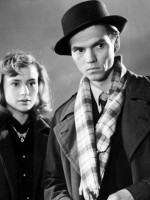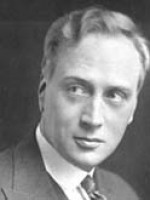Gustaf Molander is a Director and Scriptwriter Suédois born on 18 november 1888 at Helsinki (Finlande)

Gustaf Harald August Molander (18 November 1888 – 19 June 1973) was a Swedish actor and film director. His parents were director Harald Molander, Sr. (1858–1900) and singer and actress Lydia Molander, née Wessler, and his brother was director Olof Molander (1892–1966). He was the father of director and producer Harald Molander from his first marriage to actress Karin Molander and father to actor Jan Molander from his second marriage to Elsa Fahlberg.
Gustaf Molander was born in Helsinki in Finland, where his father was working at the Swedish Theatre. He studied in the school of the Royal Dramatic Theatre in Stockholm 1907–1909, acted at the Swedish theatre in Helsinki 1909–1913, and then at the Royal Dramatic Theatre from 1913–1926. The last years there he headed the school; his students included Greta Garbo.
Molander wrote several screenplays for Victor Sjöström and Mauritz Stiller, and was helped by the latter to get employment as a director for Svensk Filmindustri, where he worked 1923–1956. All in all, he directed sixty-two films. He often worked with Gösta Ekman, and his films include Intermezzo (1936), which became Ingrid Bergman's breakthrough and paved her way to America, where she starred in the 1939 Hollywood remake of the film.
Source : Wikidata
Gustaf Molander

Nationality Suede
Birth 18 november 1888 at Helsinki (Finlande)
Death 19 june 1973 (at 84 years) at Stockholm (Suede)
Birth 18 november 1888 at Helsinki (Finlande)
Death 19 june 1973 (at 84 years) at Stockholm (Suede)
Gustaf Molander was born in Helsinki in Finland, where his father was working at the Swedish Theatre. He studied in the school of the Royal Dramatic Theatre in Stockholm 1907–1909, acted at the Swedish theatre in Helsinki 1909–1913, and then at the Royal Dramatic Theatre from 1913–1926. The last years there he headed the school; his students included Greta Garbo.
Molander wrote several screenplays for Victor Sjöström and Mauritz Stiller, and was helped by the latter to get employment as a director for Svensk Filmindustri, where he worked 1923–1956. All in all, he directed sixty-two films. He often worked with Gösta Ekman, and his films include Intermezzo (1936), which became Ingrid Bergman's breakthrough and paved her way to America, where she starred in the 1939 Hollywood remake of the film.
Biography
Gustaf Molander est né à Helsingfors (aujourd'hui Helsinki) dans le grand-duché de Finlande (appartenant à l'Empire russe), où son père travaillait au Théâtre suédois. Il fit ses études à l'Académie royale d'art dramatique de Stockholm (1907-1909), joua au théâtre suédois de Helsingfors (1909-1913), puis à l'Académie royale d'art dramatique (1913-1926). Les dernières années, il dirigea l'Académie : Greta Garbo fut une de ses élèves. Contrairement à ses contemporains Victor Sjöström et Mauritz Stiller qui émigrèrent aux États-Unis, Molander demeura fidèle au cinéma suédois. Il travailla d'une façon régulière avec le plus grand acteur suédois de l'époque, Gösta Ekman, interprète aux côtés d'Ingrid Bergman, jeune débutante, d' Intermezzo (1936). À travers deux films, Chevauchée nocturne (Rid i natt!) (1942), d'après un roman de Vilhelm Moberg, et Ordet (1943), adaptation d'une œuvre théâtrale de Kaj Munk, que Carl Theodor Dreyer portera, à son tour, à l'écran en 1954, Molander condamna avec courage et fermeté le totalitarisme nazi. Après la Seconde Guerre mondiale, il collabora de façon intime avec Ingmar Bergman, qui lui écrivit les scénarios de La Femme sans visage (1947), Eva (Sensualité) (1948) et Divorce (1951).Usually with
Filmography of Gustaf Molander (23 films)
Director
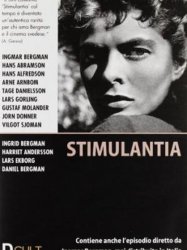
Stimulantia (1967)
, 1h45Directed by Hans Alfredson, Ingmar Bergman, Gustaf Molander, Jörn Donner, Tage Danielsson, Vilgot Sjöman
Genres Drama
Actors Sven-Bertil Taube, Hans Alfredson, Harriet Andersson, Ingmar Bergman, Daniel Bergman, Ingrid Bergman
Rating57%






Divorced (1951)
, 1h43Directed by Gustaf Molander
Genres Drama
Actors Inga Tidblad, Alf Kjellin, Doris Svedlund, Hjördis Petterson, Irma Christenson, Holger Löwenadler
Rating59%





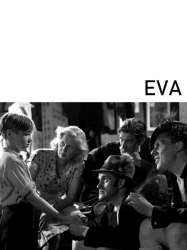
Eva (1948)
, 1h38Directed by Gustaf Molander
Genres Drama
Themes Seafaring films, Transport films, Rail transport films
Actors Birger Malmsten, Eva Dahlbeck, Åke Claesson, Hilda Borgström, Stig Olin, Wanda Rothgardt
Rating63%





As Bo (Birger Malmsten) returns home from military service, he flashes back to an episode in his childhood where he ran away from home and fell in with a band of performers. One of the performers has a daughter, a blind girl, and seeking to impress her Bo steals a locomotive. The train crashes and the girl is killed. This is first of many intrusions of death into Bo's life.

Woman Without a Face (1947)
, 1h42Directed by Gustaf Molander
Genres Drama
Actors Alf Kjellin, Anita Björk, Gunn Wållgren, Stig Olin, Olof Winnerstrand, Linnéa Hillberg
Rating64%





Un homme marié entame une liaison passionnée et tumultueuse avec une femme qu'il rencontre chez un fleuriste, plongeant leur vie dans le chaos et le désespoir.

The Word (1943)
, 1h48Directed by Gustaf Molander
Origin Suede
Genres Drama
Themes Théâtre, Films based on plays
Actors Victor Sjöström, Rune Lindström, Holger Löwenadler, Stig Olin, Wanda Rothgardt, Gunn Wållgren
Rating70%





L'action se déroule au sein d'une famille de fermiers luthériens dans la province du Jutland (Danemark). Knut Borg, le patriarche, y règne en maître incontesté. L'un de ses fils, Johannes, devrait devenir pasteur. Lors d'un accident automobile, sa fiancée est mortellement atteinte et il tente de la ressusciter. En vain... Il bascule, depuis, dans une folie d'ordre mystique. Mais, plus tard, il parvient à faire renaître Inger, la femme de l'un de ses frères, morte durant l'accouchement d'un troisième enfant...

Ride Tonight! (1942)
, 1h46Directed by Gustaf Molander
Genres Drama, Historical
Actors Oscar Ljung, Lars Hanson, Gerd Hagman, Eva Dahlbeck, Hilda Borgström, Erik "Bullen" Berglund
Rating63%





In 17th century Southern Sweden a peasant uprising takes place against German landowners.

A Woman's Face (1938)
, 1h44Directed by Gustaf Molander
Origin Suede
Genres Drama, Thriller, Crime
Actors Ingrid Bergman, Tore Svennberg, Anders Henrikson, Georg Rydeberg, Gunnar Sjöberg, Hilda Borgström
Rating69%





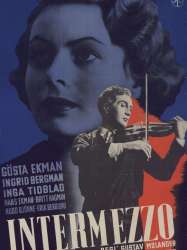
Intermezzo (1936)
, 1h33Directed by Gustaf Molander
Genres Drama, Romantic drama, Romance
Themes Films about music and musicians, Films about classical music and musicians, Musical films
Actors Gösta Ekman, Sr., Ingrid Bergman, Inga Tidblad, Erik "Bullen" Berglund, Anders Henrikson, Hugo Björne
Rating64%






Under False Flag (1935)
Directed by Gustaf Molander
Genres Comedy
Actors Ernst Eklund, Tutta Rolf, Allan Bohlin, Karin Kavli, Anna Lindahl, Erik "Bullen" Berglund

Swedenhielms (1935)
, 1h28Directed by Gustaf Molander
Origin Suede
Genres Drama, Comedy
Themes Théâtre, Films based on plays
Actors Gösta Ekman, Sr., Tutta Rolf, Ingrid Bergman, Karin Swanström, Sigurd Wallén, Mona Geijer-Falkner
Rating57%





Le film est le récit de la vie d'une famille de l'aristocratie suédoise sur le déclin, les Swendenhielms. Aveuglés par les anciens privilèges dont a pu bénéficier leur famille, les enfants et le père vivent bien au dessus de leurs moyens et s'en remettent à la fois à leur bonne de maison, Boman, et à une éventuelle récompense du prix Nobel pour le père, scientifique renommé, afin d'éviter la faillite.

Fasters millioner (1934)
, 1h30Directed by Gustaf Molander
Genres Romance
Themes Théâtre, Films based on plays
Actors Tutta Rolf, Adolf Jahr, Karin Swanström, Erik "Bullen" Berglund, Anna-Lisa Baude, Eric Abrahamsson
Rating55%






Dear Relatives (1933)
, 1h34Directed by Gustaf Molander
Origin Suede
Genres Comedy
Themes Théâtre, Films based on plays
Actors Gösta Ekman, Sr., Tutta Rolf, Carl Barcklind, Thor Modéen, Edvin Adolphson, Dora Söderberg
Rating55%





La relation entre un riche grossiste et ses trois filles est mise à l'épreuve alors qu'ils jonglent avec les affaires et les difficultés financières.

Charlotte Löwensköld (1930)
, 1h25Directed by Gustaf Molander
Genres Drama
Actors Pauline Brunius, Stina Berg, Eric Barclay, Urho Somersalmi, Alfred Lundberg
Rating54%






His English Wife (1927)
, 2h30Directed by Gustaf Molander
Genres Drama, Romance
Actors Lil Dagover, Gösta Ekman Jr., Gösta Ekman, Sr., Karin Swanström, Urho Somersalmi, Brita Appelgren
Rating60%






33.333 (1924)
, 1h21Directed by Gustaf Molander
Origin Suede
Genres Drama
Themes Théâtre, Films based on plays
Actors Stina Berg, Einar Hanson, Tora Teje
Trois hommes se cotisent pour acheter un billet de loterie dont le numéro se révélera être 33 333 et qui sera le billet gagnant.
 Connection
Connection
